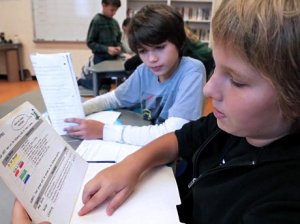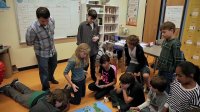How a Classroom Game Becomes an Embedded Assessment
Studying geography with Galactic Mappers shows a viable strategy for embedding assessment in a classroom game.
Your content has been saved!
Go to My Saved Content.In Galactic Mappers, a social studies game about physical geography, students compete in teams to create the most geographically diverse continent in a shared hemisphere. This group mapping project encourages students to collaborate, design, iterate, and present a finished product in a single class period.
It’s also a fun and informative way to assess my sixth grade students at Quest to Learn early in the school year—and a powerful example of an that allows me to better support the learning process.
Embedding Assessment in a Game
Galactic Mappers provides many opportunities for me to assess my students, give immediate feedback, and track their learning across a class period as they attempt to reach their goal.
As they design their first continent, I might observe a group and note how easily they construct landforms without using notes or text. Better yet, I might see a student assisting her teammates. And I can always ask certain students to define the different landforms they are about to “unlock” as they play. In this way, the game enables me to clearly identify if any student is having difficulty understanding a concept, and then support her or have a teammate do so.
The game also allows me to assess skills beyond content—primarily social and emotional learning skills. Like most games, Galactic Mappers has time limits as well as winners and losers. In the time it takes to play a complete game, I can see which students are skilled time managers and collaborators, and how each student deals with frustration and challenges.
During gameplay, I check in with groups and individuals, and record observations. I use a rubric that assesses three areas:
1. Geography skills: Students can use a key and proper labeling skills, as well as demonstrate a firm knowledge of physical geography.
2. Design: Students present a clear, neat, and visually pleasing continent that is appropriate for a map.
3. Listening: Students have the ability to listen to their teammates and teacher, as well as be a positive force in their group.

Preparation and Planning
In order to successfully implement an embedded assessment in a game like Galactic Mappers, it’s useful to lay some important groundwork in the days leading up to gameplay.
- Content preparation: First, students are required to come to class with a basic knowledge of maps and physical geography terms—content covered in the weeks leading up to the game.
- Strategic grouping: It’s important for the teacher to create balanced student groups that will function well. Students can also be assigned specific roles in their groups: The on-task manager handles materials, watches the clock, and quiets the group when the teacher addresses the class. The scribe is responsible for cutting materials, writing labels, and drawing landforms and bodies of water based on the map key. The researcher looks up information in the text or student notes when the group is stuck, and examines classroom maps for design inspiration. And the presenter presents the group’s final design at the end of each round.
- Transparency: Students should not be taken by surprise on the day of gameplay. As in test prep, they need to know what they are being assessed on, how the teacher will be assessing them, and possibly the format of the test itself. The day before we play Galactic Mappers, I show students the game cards, reveal the different rounds of play, and review student work from previous years. I make it clear that, while this is a game, it’s also an assessment of their map skills, collaboration, and time management. They’re aware that I’ll be asking them questions while they play and that I have high expectations for their teamwork skills.
Gameplay
Galactic Mappers is generally played during one 90-minute class period, but it can be adjusted to fit different schedules. Gameplay is divided into several rounds that involve both group work and whole-class discussion. Opportunities for feedback and assessment differ in each round.
- Round 1 (15 minutes): Students are given their supplies and initial continent, as well as a first set of land cards. As they play, look for any initial group dynamic issues and check for basic understanding of gameplay. Reward some groups with extra land cards for demonstrating superior knowledge or excellent time management.
- Presentation 1 (10 minutes): The class will circle around “the ocean”—the center of the classroom—as each presenter shares out their group’s continent and land cards. Reward each successful explanation with a feature card.
- Round 2 (20 minutes): Students begin to place landforms and bodies of water on their continent maps, properly shading and labeling them. Start discussions with students about where and why vegetation might grow around certain feature cards (rivers, lakes), but not others (buttes, mesas). With some groups, you may be able to have deeper discussions about where early humans might settle on their continent, while with other groups you can talk more specifically about the basics of physical geography. (What is the difference between a river and a lake? A hill and a mountain?)
- Presentation 2 (10–15 minutes): Students return to “the ocean” and place their finished continents on the class map. Presenters share out their continents and must correctly identify feature cards in order to earn points. Points are tallied and a winning group is announced.
- Class reflection (10 minutes): Before cleaning up the classroom, start a reflective discussion about the experience. Talk about the game itself, and what students may have learned from the experience. Try making a connection to future units: “Where would people want to live on the map we created?”
Next Steps
I’ve been thinking about iterations on this game to challenge students further or teach different concepts—for example, modifying it to focus on building actual continents or civilizations that students are learning about. While this may take away some of the more creative elements of the game, it would certainly ground it in the reality of the civilizations we will be studying over the course of the year.
